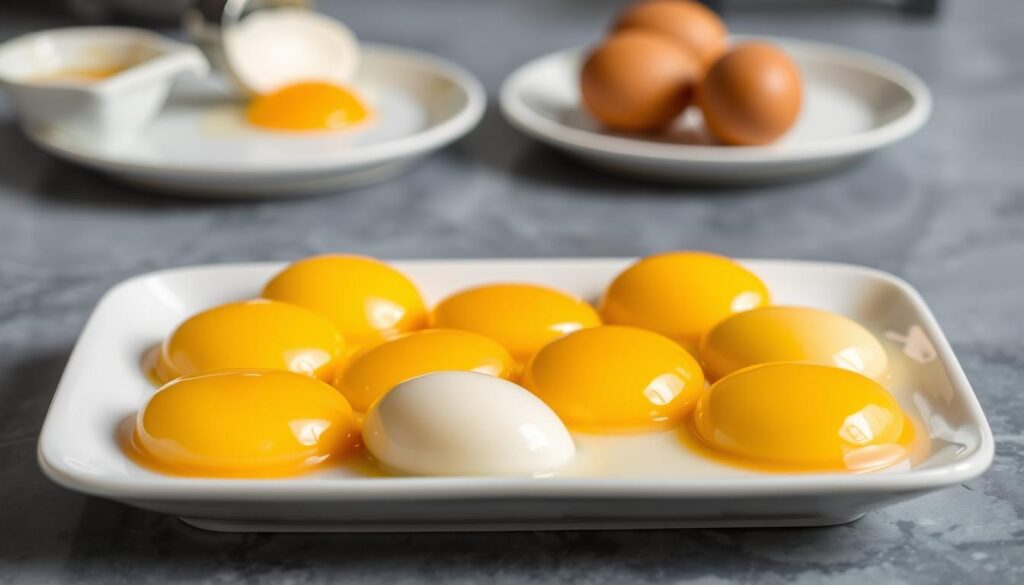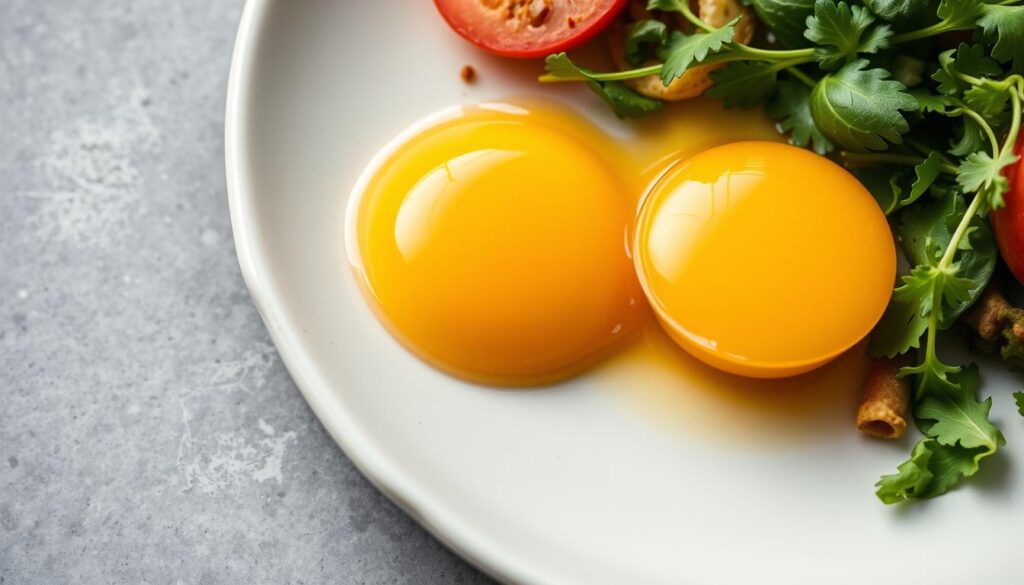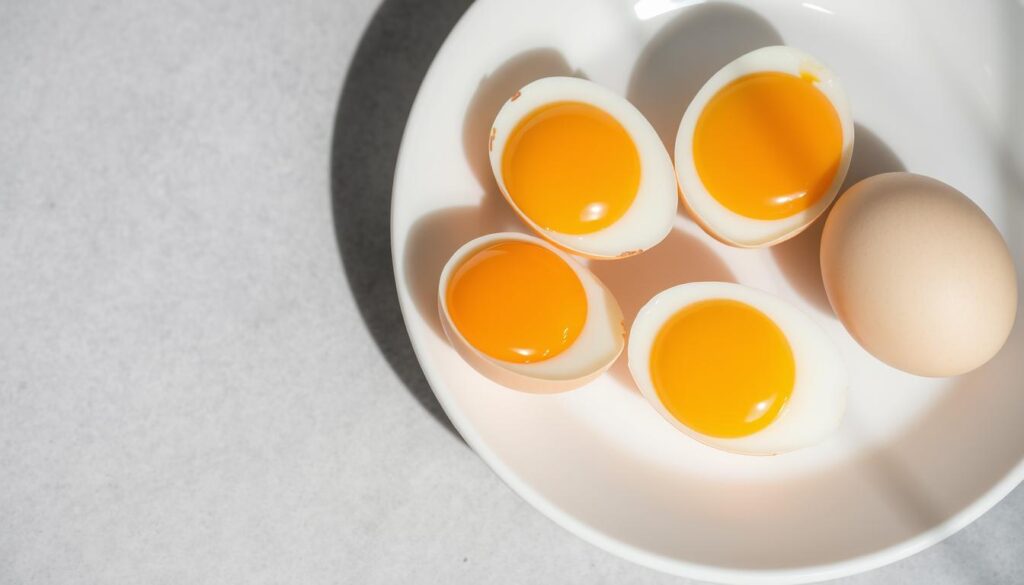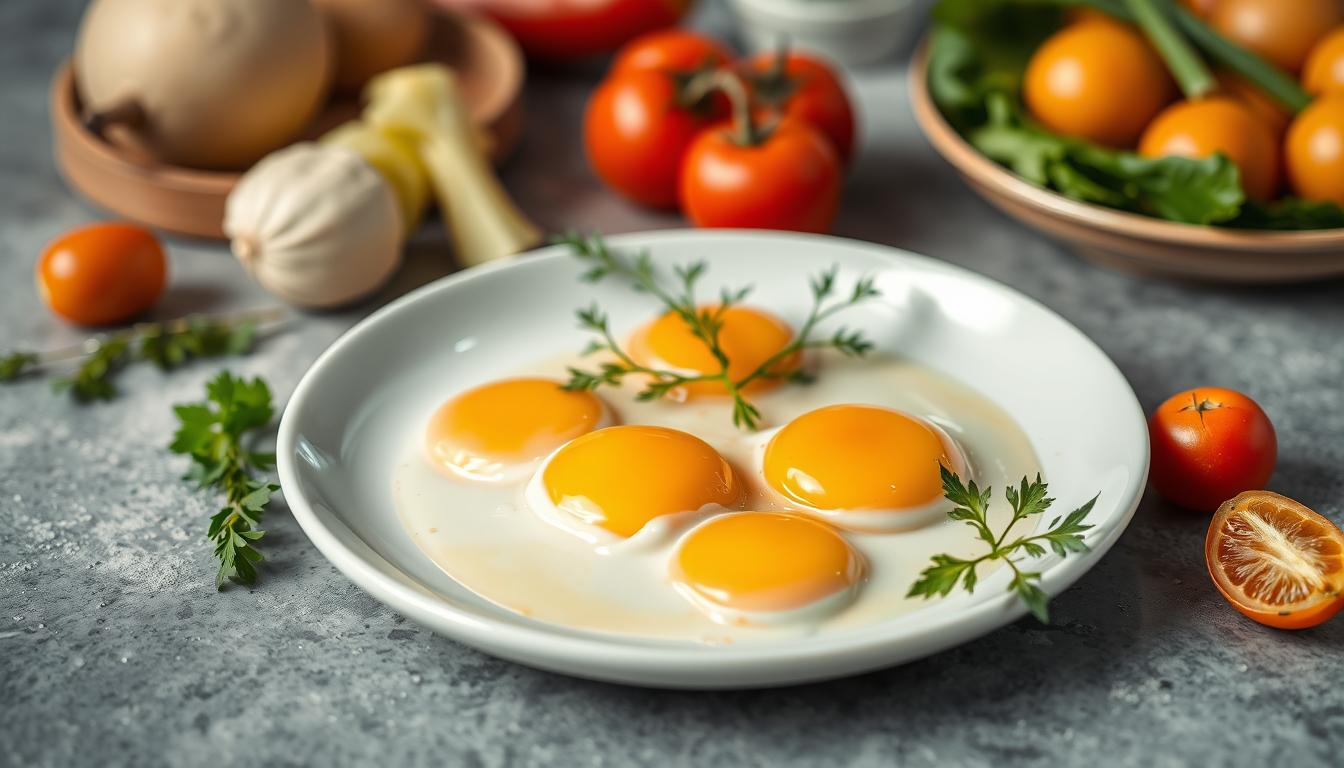Ever cracked an egg and seen a pale yolk? You might wonder if it’s safe to eat pale egg yolks. Many people ask about yolk color and its link to egg quality and safety.
Egg yolk colors range from white to deep orange. The color doesn’t always mean the yolk is unsafe. It mostly shows what the hen ate.
Knowing about pale egg yolks helps you choose better eggs. While they’re usually safe, there are things to think about for quality and nutrition.
Key Takeaways
- Pale egg yolks are typically safe to eat
- Yolk color is determined by the hen’s diet
- Nutritional content can vary based on yolk pigmentation
- Always check for signs of spoilage before consuming eggs
- Free-range eggs often have more vibrant yolk colors
Understanding Egg Yolk Color Variations
Egg yolk color is really interesting. It changes a lot depending on where the eggs come from and how the hens are raised. When you open an egg, the yolk can be pale yellow or deep orange. This shows what the hen ate and where she lived.
Natural Color Range Exploration
The colors of egg yolks are amazing. Even though they look different, they are all the same in terms of nutrition. You can find yolks in many colors, like:
- Pale yellow (lightest shade)
- Bright yellow
- Golden yellow
- Deep orange
Regional Color Differences
The color of egg yolks changes a lot depending on where they come from. Even pale yolks are just as good for you as the darker ones. What the hens eat really affects their yolk color:
| Feed Type | Resulting Yolk Color |
|---|---|
| White cornmeal | Nearly white |
| Yellow corn | Medium yellow |
| Alfalfa meal | Bright yellow |
| Marigold petals | Deep orange |
The DSM Yolk Color Fan Scale
Experts use the DSM Yolk Color Fan to measure yolk color. This scale goes from pale yellow (1) to deep orange (16). It helps them understand yolk color in a scientific way.
“Egg yolk color is nature’s way of telling us about a hen’s diet and living conditions.” – Poultry Nutrition Expert
What Determines the Color of Egg Yolks
Egg yolk color is more than just looks. It’s about nutrition, environment, and what chickens eat. Wondering about pale yolk risks or if pale egg yolks are safe? The color tells us a lot about egg quality.
Role of Carotenoids in Yolk Pigmentation
Carotenoids are key in egg yolk color. These pigments, like xanthophylls and beta-carotene, make yolks yellow to orange. Chickens get these from their food, not from making them themselves.
- Xanthophylls found in marigold, alfalfa, and leafy greens
- Beta-carotene from pumpkin and other orange vegetables
- Natural pasture foraging contributes to pigment intake
Impact of Different Feed Types
What chickens eat changes yolk color a lot. A diet full of carotenoids means eggs with deeper, brighter yolks. Feed makers add certain ingredients to match what people like.
| Feed Ingredient | Yolk Color Impact |
|---|---|
| Corn | Light yellow |
| Alfalfa | Deeper yellow |
| Marigold Petals | Orange hue |
Seasonal Variations in Yolk Color
Seasons can change yolk color a bit. In summer and spring, fresh pasture makes yolks more colorful. Winter yolks might be paler because of less foraging.
The idea that yolk color shows a hen’s health isn’t always right. Diet is the main factor.
Are Pale Egg Yolks Safe To Eat?

When you crack an egg and see a pale yellow yolk, you might worry. But, pale egg yolks are perfectly safe to eat. The color of an egg yolk doesn’t show its nutritional value or health risks.
The color of the yolk comes from what the hen eats. Hens that eat wheat and barley have pale yellow yolks. Those that eat green plants or corn have darker orange yolks. This change in color doesn’t affect the egg’s safety or what it has to offer nutritionally.
“Color is not an indicator of egg quality or safety,” says food safety experts.
- Pale egg yolks are safe to eat
- Yolk color reflects the hen’s diet
- Nutritional value remains consistent across different yolk colors
To keep eggs safe, store them right and handle them carefully. Eggs should go in the fridge and be eaten within a certain time. Always look for signs of spoilage, like bad smells or visible dirt, no matter the yolk color.
| Yolk Color | Diet Influence | Safety |
|---|---|---|
| Pale Yellow | Wheat, Barley | Safe |
| Orange | Corn, Green Plants | Safe |
Remember, the key to safe eggs is proper handling, not yolk color. Whether pale or vibrant, your eggs can be a nutritious part of your diet.
The Science Behind Yolk Pigmentation
Learning about yolk pigmentation is really interesting. It shows how eggs are full of nutrients. When you eat pale yolks, you might wonder about the science behind their color and nutrients.
Chickens can turn what they eat into egg yolks. The yolk is full of fat. This makes it perfect for storing fat-soluble pigments like carotenoids.
How Hens Process Dietary Pigments
Pale yolks are more than just a color. The process of making them involves several steps:
- Chickens eat foods full of pigments
- Carotenoids are absorbed in their gut
- Pigments go to the ovaries
- Nutrients go straight into egg yolks
Transfer of Nutrients to Yolks
The way nutrients get into yolks is very efficient. What chickens eat can change yolk color and nutrients a lot.
| Feed Type | Pigment Impact | Nutrient Transfer |
|---|---|---|
| Wheat-based diet | Pale yellow | Minimal carotenoid transfer |
| Marigold-enriched feed | Bright orange | High carotenoid concentration |
| Pasture forage | Deep orange | Maximum nutrient diversity |
“The egg yolk is nature’s perfect nutrient capsule, capable of storing and transferring essential fat-soluble compounds with remarkable precision.” – Poultry Nutrition Research
The color of your egg yolk tells a story. It shows what the chicken ate and where it lived. It’s a peek into its journey from food to egg.
Common Causes of Pale Egg Yolks
Learning why egg yolks are pale can help you choose better eggs. Pale yolks mainly come from certain foods that affect chicken health and color.
The color of egg yolks shows what the hen eats. Several things lead to pale yolks:
- Diets high in wheat, barley, or white cornmeal
- Limited access to carotenoid-rich foods
- Reduced green forage during winter months
- Commercial feed formulations designed for cost-efficiency
Chickens need certain nutrients for bright, colorful yolks. Carotenoids and xanthophylls are key for yolk color. Without these, yolks often turn pale.
“The color of an egg yolk is a direct reflection of a hen’s diet and nutritional health.”
Egg producers change feed to please customers. While pale yolks are safe, they might show diet issues. Farmers might add marigold extract or paprika to improve color and nutrition.
Seasons also change yolk color. In winter, with less green food, yolks are often lighter because of less carotenoids.
Nutrition Comparison: Pale vs. Dark Yolks
Egg yolk color tells us more than just looks. It shows what the hen ate and her health. Knowing the difference between pale and dark yolks helps you choose better.

Pale yolks are not worse than dark ones. Color changes mainly because of the chicken’s food. This means different nutrients in each.
Vitamin and Mineral Content Analysis
Egg yolk color hints at nutritional value. Here’s a look at important nutrients:
- Fat-soluble vitamins (A, D, E, K) are in both pale and dark yolks
- Darker yolks have more carotenoids
- Pasture eggs have more omega-3s
Protein and Fat Composition
Protein and fat levels are similar in all egg yolk colors. But, there are small but important differences.
| Nutrient | Pale Yolks | Dark Yolks |
|---|---|---|
| Choline | 27% Daily Value | 27% Daily Value |
| Omega-3 Fatty Acids | Lower Concentration | Higher Concentration |
| Carotenoids | Minimal | Higher Levels |
According to Poultry Science, yolk color remains the most critical egg characteristic for consumers.
What your egg looks like doesn’t tell the whole story. The hen’s diet, living space, and nutrition matter a lot. They affect the egg’s nutritional value.
Commercial Egg Production and Yolk Color
Wondering about pale egg yolks and their safety? Commercial egg production is key to understanding yolk colors. Egg farms use special methods to manage yolk color. They make sure pale yolk safety for consumers is a top priority.
Egg producers control yolk color with specific feed ingredients. Are pale egg yolks okay to eat? Yes! The color change doesn’t affect the egg’s nutritional value or safety.
- Feed companies can enhance yolk color using natural ingredients
- Marigold, paprika, and corn can influence yolk pigmentation
- Artificial color enhancement doesn’t compromise egg quality
Big egg farms have smart ways to meet what customers want. They know looks matter, so they pick feed that can change yolk color a bit.
| Production Method | Yolk Color Influence | Consumer Perception |
|---|---|---|
| Conventional Farming | Controlled Feed Ingredients | Consistent Appearance |
| Pasture-Raised | Natural Diet Variation | More Color Diversity |
Nutritional content remains consistent across different yolk colors. This means consumers can feel safe about pale yolk safety. The United Egg Producers certification ensures high-quality standards in 90% of U.S. egg production.
Yolk color is a visual indicator, not a measure of egg quality or safety.
The Role of Chicken Feed in Yolk Color
Exploring chicken nutrition is key to understanding egg yolk color. What hens eat affects their egg color and quality. This shows a complex link between diet and egg look.
Different feeds change egg yolk color a lot. Grain-based diets are very important for egg color:
- Corn-based diets make eggs bright yellow
- Wheat-based diets make eggs pale
- Mixed grain diets make yolks in between
Impact of Grain-Based Diets
What your chickens eat a lot affects egg yolk color. Wheat feed usually makes yolks pale. Corn and soy feed makes yolks yellow. The feed’s nutrition affects color and nutrients.
Effect of Natural Supplements
Natural supplements can make egg yolks brighter and more nutritious. Some ingredients can change pale yolks to vibrant colors:
- Marigold petals: Make yolks orange
- Red pepper: Deepens yolk color
- Turmeric powder: Changes yolk color a lot
“The color of an egg yolk shows what a hen eats and its nutrition.” – Poultry Nutrition Expert
Knowing about these dietary effects helps you choose better chicken feed. This improves egg yolk color and nutritional value.
Regional Diet Influences on Yolk Color
Exploring egg yolk colors shows interesting regional differences. These differences come from local farming and chicken diets. Eating pale yolks is common in some places, and it doesn’t mean the eggs are bad or unsafe.

Different areas have egg yolks of different colors because of their chicken food. For example:
- Western Canadian places like Manitoba have pale yellow yolks because of wheat and canola diets
- Eastern Canadian areas like Ontario have darker yellow yolks from corn and soybean feed
- Pasture-raised chickens make deeper orange yolks from varied foraging diets
Are pale egg yolks okay to eat? Yes! Yolk color comes from carotenoids in the chicken’s diet. A pale yellow yolk is just as good in taste and nutrition.
“The color of an egg yolk is like a culinary passport, telling the story of the hen’s diet and region.” – Poultry Nutrition Expert
People around the world like different yolk colors. Europeans like yellow yolks, while Japanese people prefer orange ones. These likes change how chicken food is made and farmed.
Knowing about regional diet effects makes us appreciate the wide world of egg making. It shows how local foods shape the eggs we eat.
Consumer Preferences and Market Standards
Egg yolk color is now a big deal in what people choose to buy. Market standards really shape our choices. Often, we judge egg quality by how it looks, not what’s inside.
Culture plays a big part in how we see egg yolks. Different places have their own likes and dislikes. This shapes what’s popular in the market:
- European folks like bright yellow yolks.
- In Japan, people go for deep orange yolks.
- In North America, opinions are all over the place.
Marketing’s Visual Influence
Food companies use yolk color to get our attention. They make darker yolks seem:
- More natural
- Better quality
- Healthier
Consumer Perception Dynamics
“Color doesn’t always equal nutrition” – Poultry Nutrition Expert
But, research shows that yolk color doesn’t really change nutrition much. Eggs are always packed with good protein and nutrients, no matter the color.
Marketers use tricks like “free-range” or “pasture-raised” to make things look better. These labels can sway our choices, even if they don’t always mean better nutrition.
Free-Range vs. Commercial Eggs: Color Differences
Free-range and commercial eggs show big color differences. This is because of the hens’ diet and where they live.
Free-range hens make eggs with brighter yolk colors. A 2007 study by Mother Earth News found big nutritional differences:
- 2/3 more vitamin A
- 3 times more vitamin E
- 2 times more omega-3 fatty acids
- 7 times more beta carotene
The yolk color can range from pale yellow to deep orange. This depends on what the hen eats. Hens that eat natural foods make yolks that are brighter orange. This is different from the pale yellow yolks of caged hens.
“Certified organic poultry is the only poultry product that is 100% guaranteed to be antibiotic-free.”
Big commercial egg farms have many hens. They don’t eat as varied a diet. Free-range chickens, on the other hand, eat grasses, insects, and seeds.
| Egg Type | Yolk Color | Dietary Characteristics |
|---|---|---|
| Commercial Eggs | Pale Yellow | Grain-based diet (wheat, corn) |
| Free-Range Eggs | Orange | Diverse diet with insects, grasses |
Even though darker yolks might look better, egg quality comes from the hen’s diet. Are pale egg yolks safe to eat? Yes! The color of the yolk doesn’t affect safety or nutrition.
check out our Chicken Salad Chick Recipe.
Conclusion
Learning about egg yolk color shows us a key fact: pale egg yolks are safe to eat. The yolk’s color mostly shows what the hen ate, not its safety or nutrition. Eggs, whether pale yellow or deep orange, are full of high-quality protein and all nine essential amino acids.
Studies show that yolk colors don’t greatly affect nutrition in a balanced diet. Eggs from different places – farms or free-range settings – are rich in proteins, vitamins, and minerals. The hen’s living conditions, diet, and health matter more than the yolk’s color. So, yes, pale egg yolks are definitely safe to eat.
When picking eggs, don’t just look at the color. Check for labels like “organic,” “free-range,” or “pasture-raised.” These often mean the hens lived better and ate better. Don’t let ads or what others think confuse you about egg quality. Fresh eggs, no matter the yolk color, are good for you if you get them from a good source and eat them as part of a healthy diet.

